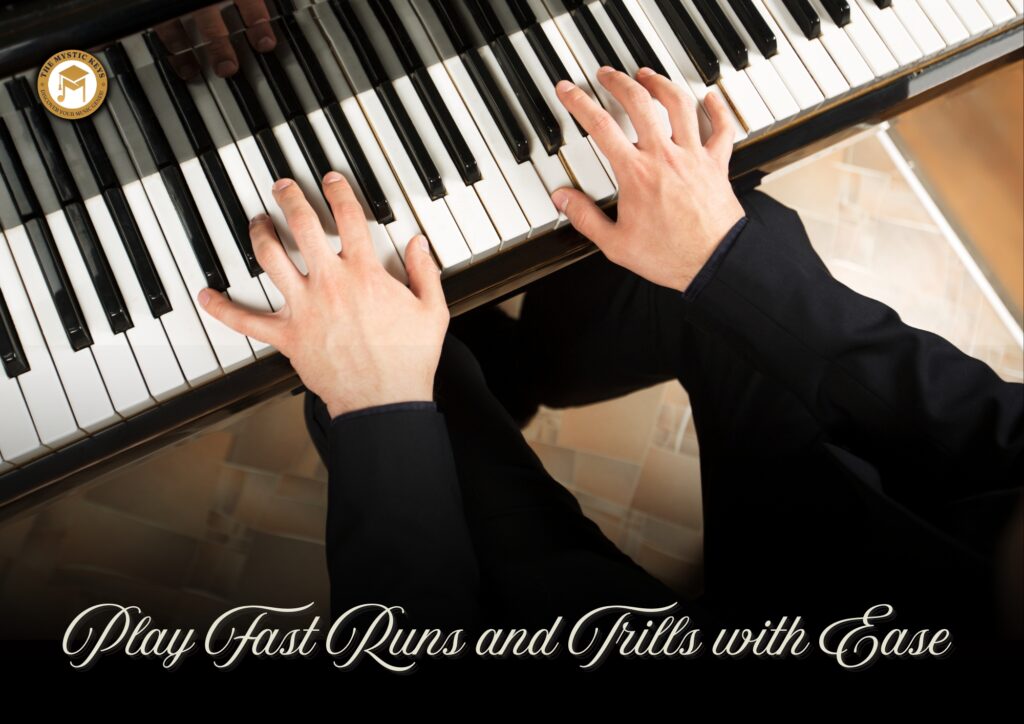How to Play Fast Runs and Trills with Ease | A Musician’s Guide
Piano runs and trills are essential elements of piano technique, contributing both to the brilliance and expressiveness of a performance. Whether you’re tackling a classical sonata, a jazz improvisation, or a contemporary piece, mastering how to play fast runs and trills can dramatically elevate your playing. However, achieving speed, control, and precision in these passages requires practice, technique, and a deep understanding of how to build up muscle memory and hand coordination.
In this blog, we will explore various methods, tips, and exercises that will help you play fast runs and trills with ease on the piano. By incorporating these strategies into your practice routine, you’ll gain the fluency and confidence needed to tackle even the most challenging passages.

Understanding Runs and Trills
Before diving into the techniques, let’s first clarify what we mean by “runs” and “trills.”
Runs refer to quick, continuous passages where you play a series of ascending or descending notes in a scale-like fashion. These can span from just a few notes to entire phrases that cover multiple octaves. Runs are often fast, requiring smooth finger movement and the ability to coordinate your hands and fingers quickly.
Trills involve rapid alternation between two adjacent notes, often a half-step or whole-step apart. Trills can appear in various musical contexts and are commonly seen in classical music, especially in Baroque and Classical works. A fast, even trill can add elegance and flair to your performance, but achieving this effect takes practice and precision.
Both runs and trills require similar techniques to execute them smoothly and accurately at high speeds. Let’s break down these techniques to help you master them.

Build Proper Hand Position and Finger Strength
One of the foundational elements to playing fast runs and trills with ease is ensuring that your hand position and finger strength are optimized.
-
Relaxed Hand Position: Your hand should be relaxed, with your wrist slightly raised. A relaxed hand reduces tension, which is critical when playing quickly. If your wrist is stiff or dropped, it can hinder fluid movement and prevent you from playing runs or trills smoothly.
-
Curved Fingers: Keep your fingers curved and positioned on the fingertips. This allows you to strike the keys quickly and efficiently without causing strain or fatigue. Flat fingers can lead to awkward movement and slower reaction times.
-
Proper Finger Strength: It’s essential to develop finger independence and strength to be able to play fast runs or trills with ease. Exercises that focus on finger strength, such as Hanon exercises or scales, can help build the muscles required for faster passages. For trills, it’s especially important to build strength in your weaker fingers, like the fourth and fifth fingers.
-
Relaxed Arm and Elbow: When playing fast runs, ensure that your arm is relaxed and moves fluidly with the motion of your hands. Tension in the arm or elbow can slow down the passage and make the run sound disconnected. Your forearm should gently follow your hand’s movement without forcing the speed.

Start Slow: Build the Foundation
Many pianists make the mistake of starting to play fast runs or trills right away without proper preparation. While speed is the goal, starting slow is essential for developing accuracy, fluidity, and control.
-
Begin Slowly: Start by playing the passage at a slower tempo. Pay attention to every note, making sure it’s clear, even, and accurate. Focus on developing smooth transitions between the notes and ensuring that your fingers are relaxed.
-
Use a Metronome: A metronome is a great tool for building your timing and precision. Start with a comfortable tempo and gradually increase the speed as you become more confident. It’s crucial to increase the tempo in small increments so you can ensure the speed is sustainable without sacrificing control or evenness.
-
Work on Coordination: For runs, practice each hand separately at first. For trills, make sure that both fingers involved in the trill are relaxed and able to alternate easily. You can also practice the trill slowly to ensure both notes are even in volume and articulation. Once you can perform the passage well with one hand, add the other hand and focus on maintaining coordination.

Finger Legato Technique
In both runs and trills, achieving a finger legato technique is key to playing the passage smoothly. This technique involves playing each note in the passage in a connected manner, without any noticeable gaps or breaks between them.
-
For Runs: Work on connecting each note smoothly as if you were playing a single continuous movement. Focus on the transition between each note, trying to avoid any choppy or disjointed sound. In runs that involve multiple octaves, be sure to rotate your hand slightly as you reach higher or lower notes.
-
For Trills: The key to a smooth trill is fluidity. Use your fingers’ natural bounce or motion to alternate between the two notes in the trill. Don’t press down too hard on the keys – this can make the trill sound stiff and mechanical. Instead, focus on a light, rapid alternation that emphasizes the flow of the movement rather than brute force.

Improve Speed with Finger Independence Exercises
As mentioned earlier, finger strength and independence are crucial to playing fast runs and trills. There are specific exercises designed to improve these aspects of your technique:
5-Finger Exercise: This exercise is great for building finger independence. Play five consecutive notes on one hand, using each finger in turn (thumb, index, middle, ring, pinky). Repeat the exercise up and down the keyboard, making sure to maintain an even sound.
Scale Practice: Practicing scales is one of the best ways to develop speed and control in runs. Start with simple scales, such as the C major scale, and practice both hands separately and together. Gradually increase the speed while keeping your fingers relaxed and your movements precise. For faster scales, try using legato technique and minimizing finger lifts.
Trill Exercises: Trill exercises are designed specifically to develop the speed and evenness of trills. Practice trills slowly with each pair of fingers (for example, playing C-D, D-E, E-F, etc.). Pay attention to articulation, and then gradually increase the tempo.

Utilize Arm Rotation and Wrist Movement
When playing runs or trills, it’s important to involve your arms and wrists to make the movements more fluid and efficient.
-
For Runs: Use a natural arm rotation for runs that span several octaves. As your hand moves up or down the keyboard, rotate your forearm slightly so your hand stays relaxed and doesn’t become cramped or tense. Your fingers should remain light, but your arm should subtly guide the motion.
-
For Trills: Trills often benefit from a gentle wrist motion, especially when playing faster. Instead of just moving your fingers, try allowing the wrist to guide the alternate motion between your two trilling fingers. This creates a smoother, less rigid motion, helping to reduce fatigue and increase speed.

Practice Specific Passages with Precision
If you’re working on a piece that includes a challenging run or trill, it’s important to focus on the problem areas. Isolate the specific part of the passage that is causing difficulty and practice it repeatedly. Break down the section into smaller parts, focusing on one hand at a time if needed. Once you have control over the individual parts, gradually put them together.

Focus on Evenness and Consistency
Fast runs and trills are not just about speed; they’re also about consistency. Each note should sound even and controlled, regardless of the tempo. To achieve this:
-
Even Dynamics: Ensure that your fingers are applying consistent pressure on the keys to avoid volume fluctuation between notes. For runs, the entire passage should be played with the same dynamic level unless the music dictates otherwise.
-
Equal Note Lengths: For both runs and trills, each note should have the same length and articulation. It’s easy to rush or pull back on certain notes, but this will make your playing sound uneven. Aim for a consistent rhythm and note length.

Conclusion
Mastering how to play fast runs and trills on the piano is a rewarding endeavor that requires patience, technique, and consistent practice. By focusing on relaxed hand position, finger strength, gradual speed increases, and proper technique, you can play these elements with ease and precision. The key is to start slow, gradually increase the tempo, and always pay attention to relaxation and fluidity in your movements.
With diligent practice, your ability to play fast runs and trills will not only improve but also add brilliance and flair to your piano performances. Keep working on your technique, and soon, you’ll find yourself playing these passages with the speed and ease that once seemed impossible.
If you’re looking for structured guidance, personalized feedback, and professional coaching, join The Mystic Keys – Piano Lessons Online and take your playing to the next level. Happy practicing!
Related Blogs
Perfect Piano Posture & Hand Position | Play Comfortably and Efficiently
Playing the piano requires more than just pressing keys—it’s about achieving the perfect balance of relaxation and control. Your posture and hand position determine how efficiently you play, how well you avoid injury, and how easily you progress in technique.
How to Develop Finger Independence for Smooth Piano Playing
Developing finger independence is a cornerstone of proficient piano playing. It enables pianists to execute complex passages with precision, expressiveness, and fluidity.
Piano Practice Structure for Effective
Improvement
At The Mystic Keys, we believe that mastering the piano practice structure is a journey that combines passion, discipline, and the right guidance. Whether you’re a beginner or an advanced pianist, a structured practice routine is the cornerstone of progress.








